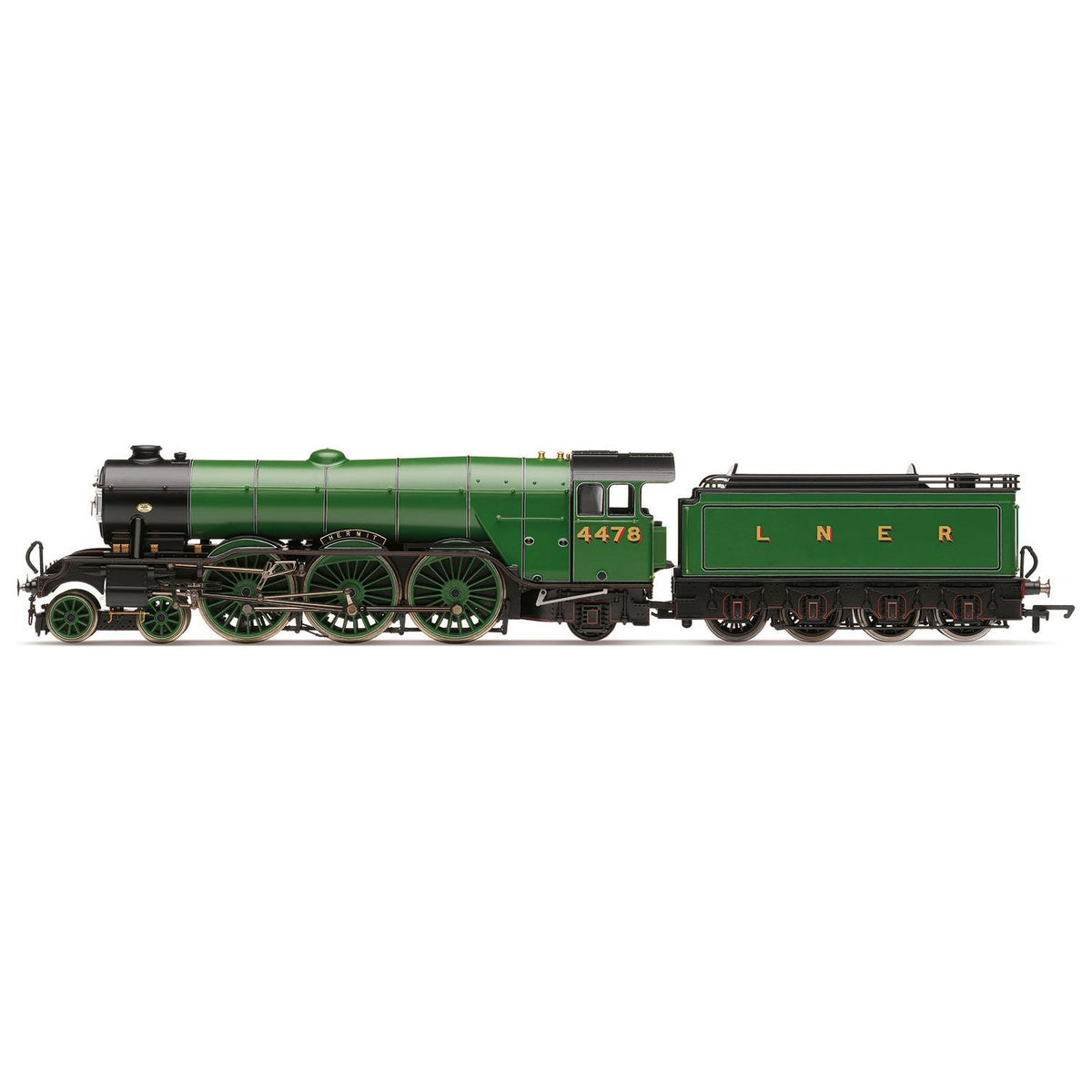HORNBY OO LNER, Class A1, 4-6-2, 4478 ‘Hermit’: Big Four Centenary Collection- Era 3 HORNBY
$ 399,99 $ 120,00
HORNBY OO LNER, CLASS A1, 4-6-2, 4478 ‘HERMIT’: BIG FOUR CENTENARY COLLECTION- ERA 3
Nigel Gresley’s A1 Pacific class emerged in the twilight years of the Great Northern Railway, a result of an idea that Gresley had nurtured since 1915. The First World War put his plans for new express passenger locomotives on hold but he applied his new three cylinder, conjugated valve gear designs to the O2 and K3 freight locomotives before returning to his plans for an express passenger Pacific in 1920, producing his 4-6-2 A1 design.
No.1470 ‘Great Northern’ was the first to enter service on the 11 April 1922 and Gresley confidently claimed that his A1 class could pull 600 ton trains which in September 1922 no.1471 ‘Sir Frederick Banbury’ did. Compared to the similar LNER design by Vincent Raven, Gresley’s A1 consumed less coal and water and was considered the better design, consequently the LNER chose the A1 design over the LNER A2.
The original eleven engines were built to the generous loading gauge of the GNR and after grouping in 1923 had to be modified to fit the loading gauge of the LNER with the chimney and dome both being reduced in height, plus the fitting of shorter safety valves.
The A1s quickly showed their ability to haul heavy loads on the East Coast Main Line but coal and water consumption was inefficient which was highlighted during the 1925 Great Western Exchange Trains with the A1s comparing unfavourably with the Castle class design. Consequent alterations to the steam lap settings and valve travel showed a reduction in coal consumption and this was adopted on all of the A1s by 1931. The piston valve rings were also replaced by the Knorr type piston valves which reduced steam loss.
Gresley had experimented with a different superheater to improve the A1s performance further but lacking significant results decided that he would increase the number of flues in the existing Robinson superheater. This coupled with an increase in boiler pressure led to improved performance and five of these new boilers were ordered in 1927 and were fitted to No.2544 ‘Lemberg’ and No.4480 ‘Enterprise’ later that year.
Trials on these two A1s proved successful and so between 1927 and 1947 all of the A1s were rebuilt as Class A3 with the exception of No.4470 ‘Great Northern’ which was eventually rebuilt by Thompson in 1945 as Class A1/1. Due to the wider header on the A3 boilers the ends projected slightly through the side of the smokebox and so cover plates were fitted to hide these projections becoming the main external distinguishing feature between the A3 and A1 locomotives.
4478 Hermit was among the first 10 of the class to be built, rolling out of Doncaster works in July 1923 and into revenue earning service with the LNER. Just over halfway through its service life the locomotive would be rebuilt into the improved A3 Class with the conversion being undertaken in November of 1943.
Withdrawal for the locomotive would take place in 1962, with all members of the class bar one being scrapped. Hermit, then 40109, was not the preserved example, with Flying Scotsman being saved and passing into railway legend due to its post-service career.
This Hornby model of ‘Hermit’ not only boasts a five pole skew wound motor but also a diecast running plate which adds increased weight for improved traction. Also worthy of note is the addition of a flickering firebox which illuminates the fully detailed cab.
Tech Specs
- Item Length – Without Packaging (cm)
- 29.1
- Item Height – Without Packaging (cm)
- 5
- Item Width – Without Packaging (cm)
- 3.5
- Item Weight – Without Packaging
- 0.39
- Item Scale
- 1:76 Scale 00 Gauge
- Finish
- Painted
- Colour
- Green
- Gauge
- OO
- DCC Status
- DCC Ready 21 pin socket
- Operator
- LNER
- Designer
- Sir Nigel Gresley
- Wheel Configuration
- 4-6-2
- Livery
- LNER Apple Green
- Minimum Curve (mm)
- Radius 2
- Motor
- 5 Pole Skew wound
- Number of Parts
- 1
- Class
- Class A1
- Buffer Type
- Sprung Metal Buffers
- Coupling Type
- NEM Tension Lock
Quick Shipping and Professional Packaging
Due to our long-term partnership in a long-standing partnership with UPS, FedEx, DHL and many other leading global carriers, we are able to offer an array of shipping options. Our warehouse staff are highly trained and will pack your products according to our precise and precise specifications. Your items will undergo a thorough inspection and be securely secured prior to being delivered. We ship to thousands clients each day across multiple countries. This is an indication of our dedication to being the biggest online retailer in the world. The warehouses are located in Europe as much as they are in the USA.
Note: Orders that include more than one item are assigned a processing time in accordance with the item.
Prior to shipment before shipping, we'll inspect thoroughly the items you've ordered. The majority of orders are shipped within 48 hrs. The time to deliver varies from 3-7 days.
Returns
We don't manage the stock in our warehouse and factory. Stocks are subject to change at any moment. You may not receive your order after the order has been made.
Our policy is for 30 days. If you have passed 30 days by since your purchase, unfortunately we can't offer you a refund or exchange.
The item cannot be used and in its original condition. It should also be in the original packaging.
Related products
RADIO CONTROL
RADIO CONTROL
RADIO CONTROL
RADIO CONTROL
RADIO CONTROL
RADIO CONTROL
RADIO CONTROL
RADIO CONTROL
RADIO CONTROL
RADIO CONTROL
RADIO CONTROL


































